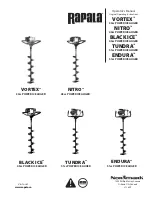
6.0 INFORMATION REGARDING USE
VL
2
VAL.130.--.M.EN Issue: A1
09.16
38
6.3 Shutdown of the valve at the end of the work cycle
There is no special switch-off procedure.
The stop of the valve is made with the shutdown of its actuator. It is advisable to drain the valve at the end
of each working day. This is particularly important when the material transported handled tend to harden or
become sticky when stored for a longer period.
6.2 Cleaning the valve after clogging
If, during normal operation, the valve actuator is found to be moving gradually under stress and then comes to
a complete stop, it is highly probable that the problem is caused by a blockage.
Danger - Warning
The authorized operator must strictly apply all laws regarding workplace safety and adopt appropriate
protective measures against work accidents.
Speci
¿
cally, do not insert the hands into the inlet/outlet next to the valve if the blade has not been
blocked safely using external means.
Danger - Warning
Disconnect the valve from all mains and use the appropriate means to prevent it from being recon-
nected accidentally.
Proceed as described.
&XWRIIWKHDFWXDWRUSRZHUVXSSO\WRWKHYDOYHRUEORFNWKHKDQGOHYHULQD¿[HGDQGVDIHSRVLWLRQ
- Remove the outlet sleeve and ensure that the outlet spout is not obstructed by material or deposits and
clean it using a tool, if necessary.
Danger - Warning
Never insert the hands inside the valve.
Before disconnecting the valve, ensure the pneumatic actuator contains no compressed air.
6.4 Long shutdowns of the valve
When the valve remains unused for long periods, proceed as described below.
1)
Empty the valve of the product it contains to prevent it from hardening.
2)
Clean the valve (see “Cleaning the valve”).
3)
Grease the coupling between valve and actuator.
4)
Grease actuator components if necessary.
5
) Repair the damaged or worn mechanical parts, if necessary.
6)
Cut the power supply.
















































